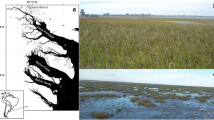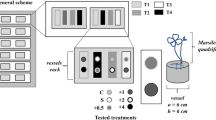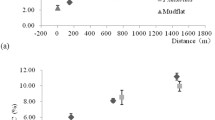Abstract
In the last century, Stratiotes aloides L. (Water Soldier) has declined considerably in the Netherlands. The species has disappeared almost completely from the littoral zones of the shallow peaty lakes it once occupied, and at present it is still abundant in ditches in nature reserves and in some agricultural areas. Originally Stratiotes aloides is a species from moderately nutrient rich and moderately alkaline waters. In large parts of the Netherlands, hydrological conditions have changed considerably owing to intensified human activities. In most peaty lowlands, water quality has been influenced not only by direct eutrophication but also by the inlet of water from the rivers Rhine and Meuse, which is characterized by a high alkalinity and relatively high sulphate levels. Additionally seepage of groundwater has strongly declined, resulting in decreased iron inputs in these aquatic systems. Increased sulphate reduction rates result in the immobilisation of iron as iron sulphide and in the generation of alkalinity. As a result phosphate is liberated from iron phosphate complexes and the decomposition of organic matter is accelerated (internal eutrophication). Next, dissolved iron levels decrease strongly while toxic sulphide accumulates in sediment pore water. As a result, iron deficiency, sulphide toxicity, ammonium toxicity and increased competition by non-rooting species have al been observed to affect Stratiotes aloides vegetation. We conclude that sulphate is the master variable in the decline of S. aloides in the Netherlands.
Similar content being viewed by others
References
Armstrong, W., 1978. Root aeration in the wetland condition. In D. D. Hook & R. M. M. Crawford (eds), Plant Life in Anaerobic Environments. Michigan: Ann Arbor: 269–297.
Cook, C. D. K. & K. Urmi-König, 1983. A revision of the genus Stratiotes (Hydrocharitaceae). Aquat. Bot. 16: 213–249.
De Lyon, M. J. H. & J. G. M. Roelofs, 1986. Aquatic macrophytes in relation to water quality and sediment characteristics. The Netherlands: Department of Ecology, University of Nijmegen (in Dutch.).
Gächter, R. & B. Müller, 2003. Why the phosphorus retention of lakes does not necessarily depend in the oxygen supply to their sediment surface. Limnol. Oceanogr. 48: 929–933.
Holmer, M., H. S. Jensen, K. K. Christensen, C. Wigand & F. O. Andersen, 1998. Sulphate reduction in lake sediments inhabited by the isoetid macrophytes Littorella uniflora and Isoetes lacustris. Aquat. Bot. 60: 307–324.
Hutchings, M. J., 1986. The structure of plant populations. In Crawley M. J. (ed.), Plant Ecology. Blackwell, Oxford: 97–136.
Kok, C. J. & B. J. Van De Laar, 1991. Influence of pH and buffering capacity on the decomposition of Nymphaea alba L. detritus in laboratory experiments. Verh. int. Ver. theor. angew. Limnol. 24: 2689–2692.
Lamers, L. P. M., H. B. M. Tomassen & J. G. M. Roelofs, 1998a. Sulphate-induced eutrophication and phytotoxicity in freshwater wetlands. Environ. Sci. Technol. 32: 199–205.
Lamers, L. P. M., S. M. E. Roozendaal & J. G. M. Roelofs, 1998b. Acidification of freshwater wetlands: combined effects of nonairborne sulfur pollution and desiccation. Wat. Air Soil Poll. 105: 95–106.
Lamers, L. P. M., A. J. P. Smolders & J. G. M. Roelofs, 2002a. The restoration of fens in the Netherlands. Hydrobiologia 478: 107–130.
Lamers, L. P.M., S. J. Fallah, E.M. Samborska, I. A. R van Dulken, G. van Hengstum & J. G. M. Roelofs, 2002b. Factors controlling the extent of eutrophication and toxicity in sulfate-polluted freshwater wetlands. Limnol. Oceanogr. 47: 585–593.
Rabe, E., 1990. Stress physiology: the functional significance of the accumulation of nitrogen-containing compounds. J. Horticult. Sci. 65: 231–243.
Rabe, E. & C. J. Lovatt, 1986. Increased arginine biosynthesis during P deficiency. Plant Physiol. 81: 774–779.
Roden, E. E. & J. W. Edmonds, 1997. Phosphate mobilization in iron-rich anaerobic sediments: microbial Fe (III) oxide reduction versus iron-sulfide formation. Arch. Hydrobiol. 139: 347–368.
Roelofs, J. G. M., 1991. Inlet of alkaline river water into peaty lowlands: effects on water quality and Stratiotes aloides L. stands. Aquat. Bot. 39: 267–293.
Segal, S., 1971. Principles on structure, zonation and succession of aquatic macrophytes. Hydrobiologia 12: 89–95.
Smits, A. J. M., P. Laan, R. H. Thier & G. Van Der Velde, 1990. Root aerenchyma, oxygen leakage patterns and alcoholic fermentation ability of the roots of some nymphaeid and isoetid macrophytes in relation to the sediment type of their habitat. Aquat. Bot. 38: 3–17.
Smolders, A. J. P. & J. G. M. Roelofs, 1993. Sulphate-mediated iron limitation and eutrophication in aquatic ecosystems. Aquat. Bot. 46: 267–293.
Smolders A. J. P. & J. G. M. Roelofs, 1995. Internal eutrophication, iron limitation and sulphide accumulation due to the inlet of river Rhine water in peaty shallow waters in the Netherlands. Arch. Hydrobiol. 133: 349–365.
Smolders, A. J. P., C. Den Hartog & J. G. M. Roelofs, 1995a. Observations of fruiting and seed-set of Stratiotes aloides L. in the Netherlands. Aquat. Bot. 51: 259–268.
Smolders, A. J. P., C. Den Hartog & J. G. M. Roelofs, 1995b. Germination and seedling development in Stratiotes aloides L. Aquat. Bot. 51: 269–279.
Smolders, A. J. P & J. G. M. Roelofs, 1996. The roles of internal iron hydroxide precipitation, sulphide toxicity and oxidizing ability in the survival of Stratiotes aloides roots at different iron concentrations in sediment pore water. New Phytol. 133: 253–260.
Smolders, A. J. P., J. G. M. Roelofs & C. den Hartog, 1996. Possible causes for the decline of the water soldier (Stratiotes aloides L.) in the Netherlands. Arch. Hydrobiol. 136: 327–342.
Smolders, A. J. P., M. C. Van Riel & J. G. M. Roelofs, 2000. Accumulation of free amino acids as an early indication for physiological stress (nitrogen overload) due to elevated ammonium levels in vital Stratiotes aloides L. stands. Arch. Hydrobiol. 150: 169–175.
Smolders, A. J. P., L. P. M. Lamers, M. Moonen, K. Zwaga & J. G. M. Roelofs, 2001. Controlling phosphate release from phosphate-enriched sediments by adding various iron compounds. Biogeochemistry 54: 219–228.
Sperber, J. L., 1958. Release of phosphate from soil minerals by hydrogen sulphide. Nature 181: 934.
Stuyfsand, P. J., 1993. Hydrochemistry and hydrology of the coastal dune area of the Netherlands. Thesis. V.U. Amsterdam, KIWA: 366 pp.
Taylor, G. J., A. A. Crowder & R. Rodden, 1984. Formation and morphology of an iron plaque on the roots of Typha latifolia L. grown in solution culture. Am. J. Bot. 71: 666–675.
Van Dijk, H. F. G. & J. G. M. Roelofs, 1988. Effects of excessive ammonium deposition on the nutritional status and condition of pine needles. Physiologia Plantarum Proceedings of the National Academy of Sciences 73: 494–501.
Van Wirdum, G., 1979. Dynamic aspects of trophic gradients in a mire complex Proc. Inf. No. 25, CHO-TNO, The Hague: 66–82.
Vines, H. M. & R. T. Wedding, 1960. Some effects of ammonia on plant metabolism and a possible mechanism for ammonium toxicity. Plant Physiol. 35: 820–825.
Weeda, E., R. Westra, C. Westra & T. Westra, 1991. Nederlandse Oecologische Flora, Wilde Planten en hun Relaties, deel 4. IVNVARA and VEWIN: 317 pp.
Wetzel, R. G., 1975. Limnology. W.B. Saunders Company, Philadelphia.
Yoshida S. & T. Tadano, 1978. Adaptation of plants to submerged soils. In Jung G. A. (ed.), Crop Tolerance to Suboptimal Land Conditions. Madison, W.I., U.S.A.: ASA, CSSA: 233–256.
Author information
Authors and Affiliations
Rights and permissions
About this article
Cite this article
Smolders, A., Lamers, L., Hartog, C.d. et al. Mechanisms involved in the decline of Stratiotes aloides L. in The Netherlands: sulphate as a key variable. Hydrobiologia 506, 603–610 (2003). https://doi.org/10.1023/B:HYDR.0000008551.56661.8e
Issue Date:
DOI: https://doi.org/10.1023/B:HYDR.0000008551.56661.8e




